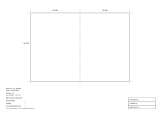
Skalowanie barometru - Wszystkie pomiary ciśnienia robione są w stosunku do wysokości nad poziomem morza, dlatego też niezbędne
jest skalowanie barometru. Przykładowo na wysokości 0 m n.p.m. barometr wskazuje 760 mm słupa rtęci, a już na wysokości 200 m n.p.m.
tylko 742 mm. Najprostszy sposób ustawienia to kontakt z lokalną stacją meteorologiczną i ustawienie barometru według danych.
Śruba regulująca - Wskazówkę ustawia się poprzez pokręcanie śruby regulującej, znajdującej się w otworze na odwrocie tarczy.
UWAGA: SKALUJĄC BAROMETR NIE WOLNO PRZEKRĘCAĆ ŚRUBY REGULUJĄCEJ WIĘCEJ NIŻ O PÓŁ OBROTU W LEWO LUB W PRAWO. BRAK
RUCHU WSKAZÓWKI OZNACZA, ŻE WSKAZÓWKA JEST ZABLOKOWANA PRZEZ TARCZĘ LUB Z POWODU ZBYT CIASNEGO OTWORU NA ZEGAR.
Termometr i higrometr zostały wyskalowane fabrycznie i nie wymagają ustawienia.
Skalowanie zegara - Mechanizm zegara ustawia się za pomocą pokrętła w tylnej części obudowy. Moduł wyposażony jest w baterię.
Przed uruchomieniem zegara należy wyjąć taśmę zabezpieczającą baterię. Należy zwrócić uwagę, aby wilgoć nie dostała się pod pokrywę
szkła urządzenia.
Zawieszenie barometru - Wieszamy barometr w dowolnie wybranym przez nas miejscu, jednak nie należy lokować go w pobliżu źródeł ciepła
ani na wilgotnych ścianach. Dotyczy to szczególnie barometrów z higrometrem i termometrem.
Odczytywanie - Przed odczytem można puknąć delikatnie w szkło zegara, można wówczas zauważyć niewielką tendencję zmiany wskazań
barometru. Aby łatwiej zaobserwować zmiany, każdorazowo po odczytaniu ciśnienia można ustawić zewnętrzną wskazówkę barometru
na jednym poziomie ze wskaźnikiem barometru (żeby wskazówki się pokrywały) - przy zmianie ciśnienia widzimy wówczas poprzednie
wskazanie barometru.
Reguły prognozy pogody - Pogoda deszczowa - przy powolnym spadku ciśnienia - wiatr i deszcz, a przy temp. poniżej 0°C - śnieg.
Przy gwałtownych zmianach ciśnienia - silne wiatry, burze, sztormy, a przy temp. poniżej 0°C - śnieżyce. Pogoda słoneczna - przy powolnym
wzroście ciśnienia - słonecznie i sucho, zimą mroźno. Przy gwałtownym i szybkim wzroście krótkotrwała ładna pogoda, mgły.
Tolerancja / dokładność pomiaru temperatury: +/- 2°C
Tolerancja / dokładność pomiaru wilgotności: +/- 4%
Tolerancja / dokładność pomiaru ciśnienia: +/- 5 hPa
Calibrating your barometer - All pressure measurements are taken in relation to the altitude above mean sea level (AMSL) and that is why
calibrating your barometer is so important. For example: the barometer indicates 760 mmHg at 0 m AMSL, whereas at 200 m AMSL it may
indicate as little as 742 mmHg. The easiest way to calibrate your barometer is to use data provided by your local weather station.
Adjusting screw - The barometer's indicator hand is set by adjusting the screw which is located in a hole at the back of the dial.
NOTE! WHEN CALIBRATING YOUR BAROMETER DO NOT TURN THE ADJUSTING SCREW MORE THAN HALF A TURN LEFT OR RIGHT.
IF THE INDICATOR HAND FAILS TO MOVE, IT MEANS THAT THE HAND IS BLOCKED BY THE DIAL OR THE DIAL HOLE IS TOO TIGHT.
Both the thermometer and the hygrometer have been calibrated by the manufacturer and they do not require any additional adjustments.
Calibrating the clock - The clock mechanism is set by a setting knob located at the back of the housing. The clock is battery-powered.
Prior to starting the clock, remove the battery protection strip. Be careful not to let moisture under the glass cover.
Mounting the barometer - You may mount your barometer in any place of your choice. Avoid mounting the barometer near sources of heat
or on damp walls (especially if your barometer is a part of weather station which also includes hygrometer and thermometer).
Taking readings - Prior to taking readings tap the glass of the barometer gently. You will notice that the barometer reading changes slightly.
To observe changes, every time the reading is taken, position the indicator hand on top of the set hand (so that both hands are in the same
position). When pressure changes, the previous barometer reading is indicated.
Weather forecast rules - Rainy weather. If pressure drops slowly: wind and rain (if temperature is below 0°C: snow).If pressure drops
rapidly: strong winds, thunderstorms and storms (if temperature is below 0°C: snowstorms). Sunny weather. If pressure increases slowly:
sunny and dry (freezing in winter). If pressure increases quickly and rapidly: short spell of good weather, fogs.
Tolerance / temperature reading accuracy: +/- 2°C
Tolerance / humidity reading accuracy: +/- 4%
Tolerance / pressure reading accuracy: +/- 5 hPa
PL
EN
No 092504, 092505, 092506
-
 1
1
w innych językach
- English: Bioterm 092505 Owner's manual
Inne dokumenty
-
Hama 00104935 Instrukcja obsługi
-
Hama 00123150 Instrukcja obsługi
-
 La Crosse Technology wireless weather station Instrukcja obsługi
La Crosse Technology wireless weather station Instrukcja obsługi
-
Hyundai WS 1868 FM Instrukcja obsługi
-
Auriol 4-LD3091 Instrukcja obsługi
-
Hyundai WSP 2080 r WIND Instrukcja obsługi
-
TFA Analogue Weather Station with Metal Ring Instrukcja obsługi
-
Hama 00186346 TS35C Outdoor Sensor Instrukcja obsługi
-
Auriol Z29592 Operation and Safety Notes
-
Hama Outdoor Sensor TS34A Instrukcja obsługi

